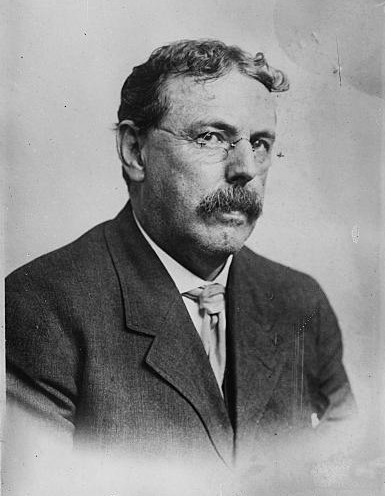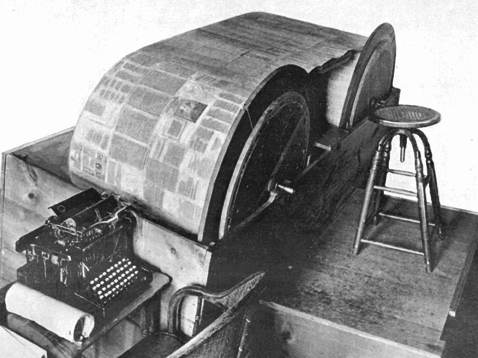Orville Ward Owen on:
[Wikipedia]
[Google]
[Amazon]
 Dr. Orville Ward Owen (January 1, 1854 – March 31, 1924) was an American physician, and exponent of the
Dr. Orville Ward Owen (January 1, 1854 – March 31, 1924) was an American physician, and exponent of the
 Owen's book ''Sir Francis Bacon's Cipher Story'' (1893-5) stated that
Owen's book ''Sir Francis Bacon's Cipher Story'' (1893-5) stated that The Shakespeare Code - The Cipher Wheel
at www.shakespearecode.com by Virginia Fellows, a 20th-century supporter of Owen's theory, who presented it to her publisher. Her book ''The Shakespeare Code'' was published in 2006 shortly after her death.
 Dr. Orville Ward Owen (January 1, 1854 – March 31, 1924) was an American physician, and exponent of the
Dr. Orville Ward Owen (January 1, 1854 – March 31, 1924) was an American physician, and exponent of the Baconian theory
The Baconian theory of Shakespeare authorship holds that Sir Francis Bacon, philosopher, essayist and scientist, wrote the plays which were publicly attributed to William Shakespeare. Various explanations are offered for this alleged subterfuge ...
of Shakespearean authorship. Owen claimed to have discovered hidden messages contained in the works of Shakespeare/Bacon. He deciphered these using a device he invented called a "cipher wheel". The alleged discoveries were published in Owen's multi-volume work ''Sir Francis Bacon's Cipher Story'' (1893–95).
Method
Owen's "cipher wheel" was a device for quickly collating printed pages from the works ofShakespeare
William Shakespeare ( 26 April 1564 – 23 April 1616) was an English playwright, poet and actor. He is widely regarded as the greatest writer in the English language and the world's pre-eminent dramatist. He is often called England's nation ...
, Francis Bacon
Francis Bacon, 1st Viscount St Alban (; 22 January 1561 – 9 April 1626), also known as Lord Verulam, was an English philosopher and statesman who served as Attorney General and Lord Chancellor of England. Bacon led the advancement of both ...
, and other authors, combining passages that appeared to have some connection with key words or phrases. Owen described this as the word cipher. A one thousand long strip of canvas had on it pasted the works of Shakespeare as well as samples by Christopher Marlowe
Christopher Marlowe, also known as Kit Marlowe (; baptised 26 February 156430 May 1593), was an English playwright, poet and translator of the Elizabethan era. Marlowe is among the most famous of the Elizabethan playwrights. Based upon the ...
and other contemporaries. When the wheels turned, key words were highlighted.
The method was examined by cryptologists William
William is a male given name of Germanic origin.Hanks, Hardcastle and Hodges, ''Oxford Dictionary of First Names'', Oxford University Press, 2nd edition, , p. 276. It became very popular in the English language after the Norman conquest of Engl ...
and Elizebeth Friedman
Elizebeth Smith Friedman (August 26, 1892 – October 31, 1980) was an American cryptanalyst and author who deciphered enemy codes in both World Wars and helped to solve international smuggling cases during Prohibition. Over the course of her ...
, who conclude that it has no cryptographic
Cryptography, or cryptology (from grc, , translit=kryptós "hidden, secret"; and ''graphein'', "to write", or '' -logia'', "study", respectively), is the practice and study of techniques for secure communication in the presence of adve ...
validity. In addition, Dr. Frederick Mann, a close friend of Owen, published a severe critique soon after Owen's book first appeared. Mann wrote that Owen's method means that "we are asked to believe that such peerless creations as Hamlet, The Tempest, and Romeo and Juliet were not prime productions of the transcendent genius who wrote them, but were ''subsidiary'' devices which Bacon designed for the purpose of concealing the cipher therein." He also noted that Owen and his assistants gave themselves considerable freedom in choosing and altering passages as they saw fit, even though the cipher-text was supposed to be identified by keywords; "in one instance the keyword is 47 lines away from the quotation taken, and in a large number of instances it is not even to be found on the same page".
Owen drew on the works normally attributed to Bacon, Shakespeare, Robert Greene, George Peele
George Peele (baptised 25 July 1556 – buried 9 November 1596) was an English translator, poet, and dramatist, who is most noted for his supposed but not universally accepted collaboration with William Shakespeare on the play ''Titus Andronicus' ...
, Edmund Spenser
Edmund Spenser (; 1552/1553 – 13 January 1599) was an English poet best known for ''The Faerie Queene'', an epic poem and fantastical allegory celebrating the Tudor dynasty and Elizabeth I. He is recognized as one of the premier craftsmen of ...
and Robert Burton
Robert Burton (8 February 1577 – 25 January 1640) was an English author and fellow of Oxford University, who wrote the encyclopedic tome ''The Anatomy of Melancholy''.
Born in 1577 to a comfortably well-off family of the landed gentry, Burt ...
, all of which he believed had been written by Bacon.
Findings
 Owen's book ''Sir Francis Bacon's Cipher Story'' (1893-5) stated that
Owen's book ''Sir Francis Bacon's Cipher Story'' (1893-5) stated that Queen Elizabeth I
Elizabeth I (7 September 153324 March 1603) was Queen of England and Ireland from 17 November 1558 until her death in 1603. Elizabeth was the last of the five House of Tudor monarchs and is sometimes referred to as the "Virgin Queen".
El ...
was secretly married to Robert Dudley, Earl of Leicester
Robert Dudley, 1st Earl of Leicester, (24 June 1532 – 4 September 1588) was an English statesman and the favourite of Elizabeth I from her accession until his death. He was a suitor for the queen's hand for many years.
Dudley's youth was ov ...
, who fathered both Bacon and Robert Devereux, 2nd Earl of Essex
Robert Devereux, 2nd Earl of Essex, KG, PC (; 10 November 1565 – 25 February 1601) was an English nobleman and a favourite of Queen Elizabeth I. Politically ambitious, and a committed general, he was placed under house arrest following a ...
, later ruthlessly executed by his own mother.Helen Hackett, ''Shakespeare and Elizabeth: the meeting of two myths'', Princeton University Press, 2009, pp.157-60 This was the basis for what became known as Prince Tudor theory. This secret history of the Elizabethan period was communicated by Bacon through encoded passages in his own works and the many others he had written attributed to other authors. Bacon's hidden messages are communicated in blank verse in the form of a question and answer session, in which a voice asks Bacon questions and receives long verse replies.
When the queen discovered that her son had written ''Hamlet'', Bacon's movements were restricted "circumscribing the free scope of that mighty intellect, and forcing the hiding of its best work under masks and cipher, only to be revealed three hundred years later".Owen, O.W., ''Sir Francis Bacon's Cipher Story'', Introduction. It was also revealed that Bacon himself discovered his brother's treasonable plot, and that ''Romeo and Juliet
''Romeo and Juliet'' is a Shakespearean tragedy, tragedy written by William Shakespeare early in his career about the romance between two Italian youths from feuding families. It was among Shakespeare's most popular plays during his lifetim ...
'' is the story of Bacon's romance with the Queen of France, Margaret of Valois
Margaret of Valois (french: Marguerite, 14 May 1553 – 27 March 1615), popularly known as La Reine Margot, was a French princess of the Valois dynasty who became Queen of Navarre by marriage to Henry III of Navarre and then also Queen of France a ...
. Elizabeth confessed that Bacon was her son on her deathbed, but she was poisoned and strangled by Robert Cecil to prevent her proclaiming Bacon her successor. Owen also uncovered two new plays by Bacon, ''The tragical historie of our late brother Robert, earl of Essex'' and ''The historical tragedy of Mary queen of Scots''.
Owen was led to the belief that original manuscripts were hidden in iron boxes buried beneath or close to the River Wye
The River Wye (; cy, Afon Gwy ) is the Longest rivers of the United Kingdom, fourth-longest river in the UK, stretching some from its source on Plynlimon in mid Wales to the Severn estuary. For much of its length the river forms part of Wal ...
at Chepstow Castle
Chepstow Castle ( cy, Castell Cas-gwent) at Chepstow, Monmouthshire, Wales is the oldest surviving post-Roman stone fortification in Britain. Located above cliffs on the River Wye, construction began in 1067 under the instruction of the Norman L ...
. After a fruitless search in caves near the castle in September 1909, he returned late the following year and excavated the river bed a few hundred yards above the castle in the belief that a rift in the river bed held a vault containing 66 lead-lined boxes. The search attracted widespread media interest, and up to 24 men were employed to dig out the mud and shore up the sides. Although Owen failed to find any evidence of the vault or boxes, he did discover the remains of a Roman bridge near the castle, and a previously unrecorded medieval water cistern
A cistern (Middle English ', from Latin ', from ', "box", from Greek ', "basket") is a waterproof receptacle for holding liquids, usually water. Cisterns are often built to catch and store rainwater. Cisterns are distinguished from wells by t ...
.Times Literary Supplement 23/4/10 p.3
Owen died a "bedridden almost penniless invalid", full of regret for sacrificing his career, reputation and health on the "Baconian controversy" and warning admirers to learn by his example and avoid it. His theories were later developed by his assistant Elizabeth Wells Gallup
Elizabeth Wells Gallup (1848 in Paris, New York – 1934) was an American educator and exponent of the Baconian theory of Shakespearean authorship.
Early life and education
Gallup was born in 1848. She studied at Michigan State Normal College (n ...
.
Owen's cipher wheel was discovered in a warehouse in Detroitat www.shakespearecode.com by Virginia Fellows, a 20th-century supporter of Owen's theory, who presented it to her publisher. Her book ''The Shakespeare Code'' was published in 2006 shortly after her death.
Footnotes
Further reading
* Virginia M. Fellows, ''The Shakespeare Code'', Snow Mountain Press, 2006. . * O.W. Owen, ''Sir Francis Bacon's cipher story'' I-V, Howard Publishing, 1893-5. Reprinted 1995, . {{DEFAULTSORT:Owen, Orville Ward 1854 births 1924 deaths Baconian theory of Shakespeare authorship American people of Welsh descent Shakespeare authorship theorists